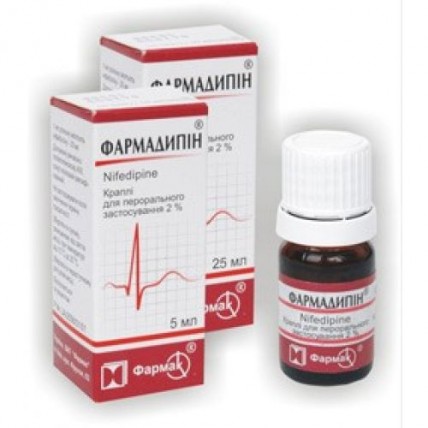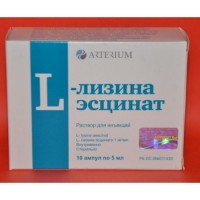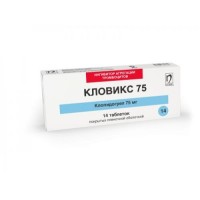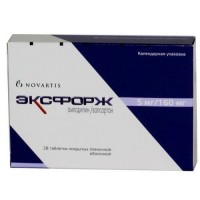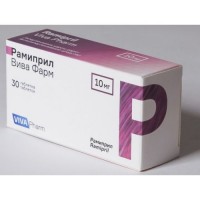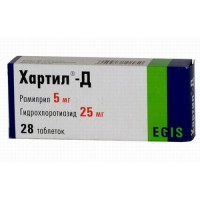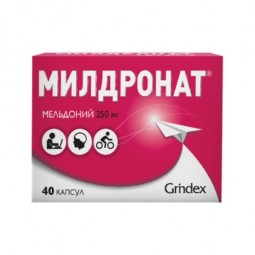Pharmadipin 2% 5 ml oral drops
- $5.70
The instruction for medical use
of FARMADIPIN medicine
the Trade name
Pharmadipin
Mezhdunarodnoye the unlicensed
name Nifedipine Dosage Form
of the Drop for oral administration of 2%
Structure
of 1 ml of solution contains
active agent - nifedipine in terms of 100% substance - 20 mg,
excipients: a macrogoal of 400 - 0.8 ml, ethanol (96%) up to 1 ml
the Description
Transparent viscous liquid of yellow or chartreuse color with a slight alcohol smell
Pharmacotherapeutic group
Blockers of slow calcium channels selection. Dihydropyridinic derivatives.
ATC C08C A05 code
the Pharmacological
Pharmacokinetics At properties intake is well soaked up in a digestive tract, bioavailability of 40-60%. Especially quickly (in 5-10 min.) the effect develops at sublingual reception. Usually the maximum of action is registered in 30-40 minutes. Meal significantly does not influence drug absorption speed. The hemodynamic effect remains for 4-6 hours. About 90% of nifedipine contact proteins of blood plasma. It is metabolized in a liver and brought out of an organism mainly in the form of inactive metabolites. The general clearance of nifedipine - from 0.4 to 0.6 l/kg/h. Elimination half-life makes 2-4 hours. At people of advanced age and patients with cirrhosis the metabolism of nifedipine slows down therefore their elimination half-life of drug can be extended almost twice that demands reduction of a dose and increase in intervals between administrations of drug. In an organism nifedipine does not kumulirut. In insignificant quantities gets through hematoencephalic and placentary barriers, it is allocated with breast milk.
Pharmadipin's pharmacodynamics shows anti-anginal and antihypertensive action. Blocks entry of calcium ions into cardiomyocytes and smooth muscle cells of coronary and peripheral arteries through slow potentsialzavisimy calcium channels of cell membranes. Relaxes unstriated muscles of vessels, liquidates spasms and expands coronary and peripheral arteries, reducing the peripheric vascular resistance, arterial blood pressure, an afterload and the need of a myocardium for oxygen, slightly reduces contractility of a myocardium, reduces aggregation of thrombocytes a little.
Indications
- arterial hypertension (for the purpose of treatment of hypertensive crises)
the Route of administration and doses
At sudden increase in arterial blood pressure (the ABP of 180/100 mm Hg - 190/110 mm Hg) the initial single dose for adults makes 3-5 drops (2 mg – 3.35 mg), to persons of advanced and senile age – no more than 3 drops (2 mg) under language or to drop on a piece of a cracker or sugar, as long as possible holding in a mouth. At insufficient efficiency the dose can gradually be raised to clinically significant effect. Further in cases of increase in arterial blood pressure it is necessary to be guided by this dose. If necessary (increase in the ABP to 190/100 mm Hg. – 220/110 mm Hg.) the single dose can be raised gradually in some cases till 10-15 drops (6.7 mg-10 mg) taking into account individual changes of indicators of the ABP at the patient. The maximum single dose – 10 mg (15 drops).
The maximum daily dose – 15-30 mg (21kaplya-45 a thaw).
Side effects
- nausea
- tachycardia
- arterial hypotension
- a stethalgia
- 'inflows' of blood to the person and an upper part of a trunk
- hypostases of legs
- weakness, dizziness, a headache, drowsiness
Seldom
- allergic reactions in the form of skin rashes
- parasthesias
- a depression
- a tremor of fingers of hands
- increase in a daily urine
- a disorder of vision
- a hyperplasia of gums (at prolonged use)
Contraindications
- allergic reaction to drug components
- cardiogenic shock, an acute myocardial infarction, unstable stenocardia, tachycardia
- heavy aortal and mitral stenoses
- arterial hypotension
- the profound heart failure
- weakness of sinus node
- a porphyria
- pregnancy and the period of a lactation
- to children up to 18 years
Medicinal interactions
Hypotensive action of Pharmadipin strengthen drugs from group of β-adrenoblockers, nitrates, diuretics, other antihypertensive drugs, tricyclic antidepressants, alkogolsoderzhashchy drugs and drinks. In some cases nifedipine causes decrease in concentration of quinidine in blood plasma, and its cancellation — its substantial increase. Proceeding from it, when performing combination therapy it is recommended to watch concentration of quinidine in blood plasma. Diltiazem reduces Pharmadipin's clearance. Fentanyl considerably enhances hypotensive effect therefore it is necessary to stop Pharmadipin's reception not less than in 36 hours prior to administration of fentanyl. When sharing β-adrenoblockers with Pharmadipin the development of arterial hypotension and heart failure is possible (especially with propranolol). Pharmadipin increases concentration of digoxin, carbamazepine and theophylline in blood. Cimetidinum increases Pharmadipin's concentration in blood plasma. Rifampicin weakens therapeutic effect of Pharmadipin, accelerating his metabolism.
Special instructions
It is necessary to consider individual sensitivity of certain patients to Pharmadipin. In such cases the dose is selected individually, since three drops and gradually to increase by 2-3 drops (1.34 mg - 2 mg) before achievement of clinical effect.
Exceeding an initial dose of drug can lead to a sharp lowering of arterial pressure!
Features of influence of medicine on ability to run the vehicle or potentially dangerous mechanisms
Drug can influence a psychophysical condition of patients that is shown by easing of attention, delay of reactions, and demands care at control of vehicles and work with potentially dangerous mechanisms.
Overdose
Symptoms: sharp lowering of arterial pressure, heart failure, shock, metabolic acidosis and spasms.
Treatment: gastric lavage, intake of activated carbon, introduction of sympathomimetics, Calcii chloridum, symptomatic therapy.
A form of release and packing
of the Drop for oral administration of 2%. On 5 ml or 25 ml in bottles glass, enclosed with the instruction for medical use in a cardboard pack.
To Store storage conditions in dry, protected from light and the place, inaccessible for children, at a temperature from 15 ºС up to 25 ºС.
To store out of children's reach!
A period of storage
3 years
it is not necessary to use drug after the termination of the expiration date specified on packing.
Prescription status
According to the prescription
JSC Pharmak Adres Producer: Ukraine, 04080, Kiev, st. of Frunze, 63.
of FARMADIPIN medicine
the Trade name
Pharmadipin
Mezhdunarodnoye the unlicensed
name Nifedipine Dosage Form
of the Drop for oral administration of 2%
Structure
of 1 ml of solution contains
active agent - nifedipine in terms of 100% substance - 20 mg,
excipients: a macrogoal of 400 - 0.8 ml, ethanol (96%) up to 1 ml
the Description
Transparent viscous liquid of yellow or chartreuse color with a slight alcohol smell
Pharmacotherapeutic group
Blockers of slow calcium channels selection. Dihydropyridinic derivatives.
ATC C08C A05 code
the Pharmacological
Pharmacokinetics At properties intake is well soaked up in a digestive tract, bioavailability of 40-60%. Especially quickly (in 5-10 min.) the effect develops at sublingual reception. Usually the maximum of action is registered in 30-40 minutes. Meal significantly does not influence drug absorption speed. The hemodynamic effect remains for 4-6 hours. About 90% of nifedipine contact proteins of blood plasma. It is metabolized in a liver and brought out of an organism mainly in the form of inactive metabolites. The general clearance of nifedipine - from 0.4 to 0.6 l/kg/h. Elimination half-life makes 2-4 hours. At people of advanced age and patients with cirrhosis the metabolism of nifedipine slows down therefore their elimination half-life of drug can be extended almost twice that demands reduction of a dose and increase in intervals between administrations of drug. In an organism nifedipine does not kumulirut. In insignificant quantities gets through hematoencephalic and placentary barriers, it is allocated with breast milk.
Pharmadipin's pharmacodynamics shows anti-anginal and antihypertensive action. Blocks entry of calcium ions into cardiomyocytes and smooth muscle cells of coronary and peripheral arteries through slow potentsialzavisimy calcium channels of cell membranes. Relaxes unstriated muscles of vessels, liquidates spasms and expands coronary and peripheral arteries, reducing the peripheric vascular resistance, arterial blood pressure, an afterload and the need of a myocardium for oxygen, slightly reduces contractility of a myocardium, reduces aggregation of thrombocytes a little.
Indications
- arterial hypertension (for the purpose of treatment of hypertensive crises)
the Route of administration and doses
At sudden increase in arterial blood pressure (the ABP of 180/100 mm Hg - 190/110 mm Hg) the initial single dose for adults makes 3-5 drops (2 mg – 3.35 mg), to persons of advanced and senile age – no more than 3 drops (2 mg) under language or to drop on a piece of a cracker or sugar, as long as possible holding in a mouth. At insufficient efficiency the dose can gradually be raised to clinically significant effect. Further in cases of increase in arterial blood pressure it is necessary to be guided by this dose. If necessary (increase in the ABP to 190/100 mm Hg. – 220/110 mm Hg.) the single dose can be raised gradually in some cases till 10-15 drops (6.7 mg-10 mg) taking into account individual changes of indicators of the ABP at the patient. The maximum single dose – 10 mg (15 drops).
The maximum daily dose – 15-30 mg (21kaplya-45 a thaw).
Side effects
- nausea
- tachycardia
- arterial hypotension
- a stethalgia
- 'inflows' of blood to the person and an upper part of a trunk
- hypostases of legs
- weakness, dizziness, a headache, drowsiness
Seldom
- allergic reactions in the form of skin rashes
- parasthesias
- a depression
- a tremor of fingers of hands
- increase in a daily urine
- a disorder of vision
- a hyperplasia of gums (at prolonged use)
Contraindications
- allergic reaction to drug components
- cardiogenic shock, an acute myocardial infarction, unstable stenocardia, tachycardia
- heavy aortal and mitral stenoses
- arterial hypotension
- the profound heart failure
- weakness of sinus node
- a porphyria
- pregnancy and the period of a lactation
- to children up to 18 years
Medicinal interactions
Hypotensive action of Pharmadipin strengthen drugs from group of β-adrenoblockers, nitrates, diuretics, other antihypertensive drugs, tricyclic antidepressants, alkogolsoderzhashchy drugs and drinks. In some cases nifedipine causes decrease in concentration of quinidine in blood plasma, and its cancellation — its substantial increase. Proceeding from it, when performing combination therapy it is recommended to watch concentration of quinidine in blood plasma. Diltiazem reduces Pharmadipin's clearance. Fentanyl considerably enhances hypotensive effect therefore it is necessary to stop Pharmadipin's reception not less than in 36 hours prior to administration of fentanyl. When sharing β-adrenoblockers with Pharmadipin the development of arterial hypotension and heart failure is possible (especially with propranolol). Pharmadipin increases concentration of digoxin, carbamazepine and theophylline in blood. Cimetidinum increases Pharmadipin's concentration in blood plasma. Rifampicin weakens therapeutic effect of Pharmadipin, accelerating his metabolism.
Special instructions
It is necessary to consider individual sensitivity of certain patients to Pharmadipin. In such cases the dose is selected individually, since three drops and gradually to increase by 2-3 drops (1.34 mg - 2 mg) before achievement of clinical effect.
Exceeding an initial dose of drug can lead to a sharp lowering of arterial pressure!
Features of influence of medicine on ability to run the vehicle or potentially dangerous mechanisms
Drug can influence a psychophysical condition of patients that is shown by easing of attention, delay of reactions, and demands care at control of vehicles and work with potentially dangerous mechanisms.
Overdose
Symptoms: sharp lowering of arterial pressure, heart failure, shock, metabolic acidosis and spasms.
Treatment: gastric lavage, intake of activated carbon, introduction of sympathomimetics, Calcii chloridum, symptomatic therapy.
A form of release and packing
of the Drop for oral administration of 2%. On 5 ml or 25 ml in bottles glass, enclosed with the instruction for medical use in a cardboard pack.
To Store storage conditions in dry, protected from light and the place, inaccessible for children, at a temperature from 15 ºС up to 25 ºС.
To store out of children's reach!
A period of storage
3 years
it is not necessary to use drug after the termination of the expiration date specified on packing.
Prescription status
According to the prescription
JSC Pharmak Adres Producer: Ukraine, 04080, Kiev, st. of Frunze, 63.
